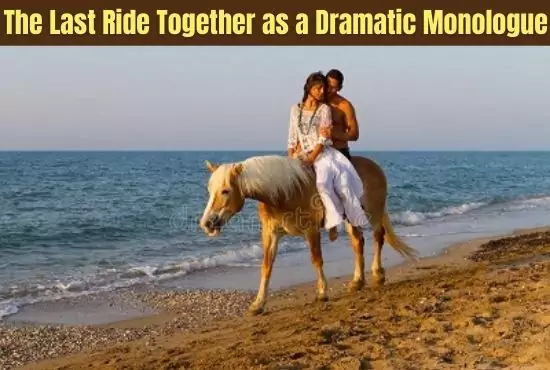The Last Ride Together as a Dramatic Monologue
The dramatic monologue is Browning’s most important innovation in form. It is the detached speech in which he takes some individual at a highly critical moment of his life, and instead of dissecting him from the outside, as an ordinary novelist would do, he penetrates to the depth of his nature, and through his own utterance makes him lay bare the innermost secrets of his life-his motive good or bad, his temperament, his personality the aberration of his thought, his self-deception, his way of looking at life. In short, in a dramatic monologue a soul’s history is told in an episode of an hour.
The dramatic monologue is predominantly psychological, analytical and argumentative like the soliloquy. But while in a soliloquy the person concerned speaks to, and argues with himself, in a dramatic monologue the speaker speaks and addresses his arguments to another person who generally keeps silent.
“The ideal aim of a dramatic monologue may be defined as the faithful self-portrayal, without ulterior purpose, of the personality of the supposed speaker.” (Hudson)
But in actual practice a dramatic monologue is commonly used as the medium of the poet’s own philosophy. The speaker, in expressing his own ideas, acts as the mouthpiece of the poet. Browning’s dramatic monologues are mostly personal.
The Last Ride Together is a fine specimen of the dramatic monologue. Browning catches the rejected lover at the most critical moment of his life- the moment when he is riding with the girl who has jilted him and reveals the facet after facet of the lover’s character- his fatalism which makes him take his rejection as a decree of fate, his vigorous optimism which leads him to pluck the sting out of failure and make of its something better than success and his vivid imagination which makes him see eternity in a particular moment. The pressure of the moment forces into high relief the real underlying temperament of the rejected lover obscured in normal times. The elements and energies of his life come out tightly knotted in microcosmic completeness during the ride.
Also Read:
The Last Ride Together is predominantly argumentative and analytical. The rejected lover argues why he should not mourn his failure in love which means, in effect, the very failure of his life. He argues,
“Fail I alone, in words and deeds?
Why, all men strive and who succeeds?”
He argues that failure is a must on this earth, because the limitations of the material body stand in the way of a man translating all his thoughts into action:
“What act proved all its thought had been?
What will but felt the fleshy screen?”
He analyses the achievements of a statesman, a soldier, a poet, a sculptor – and a musician and shows that he is better rewarded than they. He also argues that complete success is not desirable on earth, because that will mean for one a dull and dreary life in heaven.
The Last Ride Together is a typical dramatic monologue of Browning though it does not fulfill the ideal aim of this species of poetry, which is to give the faithful self-portrayal of the speaker’s personality. The rejected lover, in expressing his philosophy of life acts as the mouthpiece of Browning. In this respect the poem is in sharp contrast to (i.e. the speaker) has nothing to do with his creator’s philosophy of life.
Like other dramatic monologues of Browning the poem begins abruptly with the words, “I said- Then, Dearest, since its so”. He also makes use of the conversational method. The silent reactions of the lady-love, as indicated by the rejected lover (i.e. the speaker) himself during his speech by such expression as “right” and “Try and Test” draw out the lover’s mind like the remarks of the interlocutor in a dialogue.

Hello, Viewers! Besides being the Founder and Owner of this website, I am a Government Officer. As a hardcore literary lover, I am pursuing my dream by writing notes and articles related to Literature. Drop me a line anytime, whether it’s about any queries or demands or just to share your well-being. I’d love to hear from you. Thanks for stopping by!
